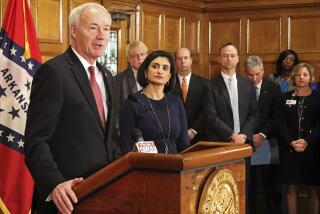Unintended Consequences Haunt Welfare Reformers : Benefits: Attempts to overhaul programs resulted in unexpected social problems. Clinton tries to avoid pitfalls.
WASHINGTON — When the federal government established its first broad public assistance program as part of the New Deal reforms of 1935, its authors saw it primarily as a way to support needy widows and their children.
No one could have predicted that nearly six decades later, more than half of the recipients would be unwed mothers, and Aid to Families With Dependent Children would be widely blamed for subsidizing out-of-wedlock childbirth and destroying families.
Likewise, when Congress created a generous medical plan for welfare families during the Great Society of the 1960s, no one expected that it would leave parents feeling trapped in the system, reluctant to take jobs for fear of losing their Medicaid benefits.
And when President Ronald Reagan tightened the rules governing the maximum earnings and assets that welfare recipients could have without losing their benefits, the last thing he wanted was to encourage welfare over work.
“There’s no greater gap between our good intentions and our misguided consequences than you see in the welfare system,” President Clinton said as he introduced his welfare reform package last week in the lobby of a Kansas City, Mo., bank. “It started for the right purpose of helping people who fall by the wayside. . . . But for many, the system has worked to undermine the very values that people need to put themselves and their lives back on track.”
Mindful of the lessons of the past, the Clinton Administration hopes it has seen the potential pitfalls clearly enough to avoid creating its own unintended consequences. Nonetheless, welfare specialists warn that despite their good intentions, the President’s reformists still could produce a range of undesirable repercussions--from an increase in the ranks of homeless children to the development of a public works program much larger and costlier than the Administration anticipates.
It is difficult to accurately foresee the effects of major social change when political concerns are forcing the policies to be put in place so rapidly, said Mark Greenberg, a senior attorney at the Center for Law and Public Policy. In a different political climate, most of the initiatives in the Administrations’s plan probably would have been tested first, he added.
The President’s plan would offer welfare recipients born after 1971 a new deal. The government would provide job training or education to people who are not “job ready.” But after two years, participants would have to find work in the private sector or spend 15 to 30 hours a week in a government-subsidized job. Child care would be offered as a further inducement. Those who refuse to participate would lose their welfare benefits entirely.
The proposal also would enforce laws requiring unwed mothers to identify the fathers of their children and would tighten child-support collection procedures. The reform plan also calls for a national campaign designed to discourage teen-age pregnancy and a new requirement that teen-age mothers live with a parent or guardian to qualify for government assistance.
Some Democrats in Congress and liberal welfare experts believe that by cutting all cash assistance to parents who refuse to get jobs, the government could hurt children, the very people the program was created to protect.
“I’m particularly concerned about the two-year time limit,” said Rep. Robert T. Matsui (D-Sacramento). “If it’s enforced strictly, it could result in orphanages being set up and children being taken from their parents and put there or in the bankrupt foster-care system.”
Administration officials argue that given the stark choice between going without and having to work, parents will think about what’s best for their children and report to their jobs. But Doug Besharov, a welfare expert at the conservative American Enterprise Institute, said this view “seriously underestimates the inertia factor.”
Even some Administration officials who worked on the plan quietly expressed their own worries about the time limit.
“My biggest fear is that the sanction gets applied quite punitively and the reform does not provide the help we intended it to provide, so welfare becomes an even more adversarial place than it is now,” said one Administration official who spoke on condition of anonymity.
The time limit is not the only part of the Clinton plan that bothers experts.
Robert Greenstein, executive director of the liberal Center on Budget and Policy Priorities, said the President’s plan would turn welfare into the “biggest training program ever mounted,” with 900,000 people in mandatory education and training by 1997.
In Iowa, where a new state law requires everyone receiving welfare benefits to participate in education or training programs aimed at preparing them for jobs, local officials complain that they are quickly running out of slots.
Another part of the President’s plan, subsidized work for those who cannot find positions in the private labor market, also lies in uncharted territory.
If states are forced to create large numbers of subsidized jobs, they could unintentionally drive down wages for unskilled workers.
“The whole structure is untested,” Greenstein said. “We really do not know until we try what it will work like in the real world. It would have been better if the Administration was proposing major demonstrations before phasing it in.”
Other specialists said the states are unlikely to create enough jobs, thereby producing an entirely different accidental effect.
“Creating jobs at a local level is hard work, and most states have shown very little interest in it,” said Demetra Nightengale, a welfare expert at the Urban Institute, a Washington-based, nonpartisan research center.
Administration officials agree that many aspects of the Clinton-style welfare reform are untried, but insist that the plan is flexible enough to be adapted if problems arise.
Theda Skocpol, a Harvard University sociology professor, argues that the sloganeering the Administration uses will have an undesired impact of its own.
“The heightened rhetoric creates greater resentment when these people do not disappear,” she said. “Welfare reform is its own biggest enemy. First there was the War on Poverty, now it’s end welfare as we know it. The public comes to expect results and does not get them and then resents any attempts as wasted money. The rhetoric has far outrun what they are going to be able to deliver.”
The history of welfare reform is full of examples of good intentions gone awry.
When Congress last considered welfare reform, it was inspired by a growing public sentiment that welfare recipients should work. But because both funding and follow-through were inadequate, the 1988 Family Support Act put few people into the work force, even though tens of thousands more welfare recipients entered education and training programs.
“The jobs program turned out to be more of an education program than Congress intended,” Nightengale said.
In 1981, the Ronald Reagan Administration changed AFDC rules, lowering the level of assets welfare recipients could possess and still qualify for AFDC. The percentage of AFDC families who worked dropped from 14% to 15% before 1981 to 4% to 5% afterward.
“The goal at the time was to target assets to the truly needy,” Greenberg said. “They increased the penalties on work, savings and marriage, and the effect of that has been to decrease the percentage of people on AFDC working at any time.”
Conservatives and liberals alike agree that one of the clearest unintended consequences of welfare policy was to encourage women to become dependent on the benefits and to stay that way.
The current caseload has hit a record 14.3 million, with more than 30% of recipients remaining on the rolls for eight years. One in seven children benefits from AFDC. A key reason for that dependency, according to the President and many welfare experts, is that the program, especially its medical benefits, is so attractive that many recipients feel that they will lose by taking low-paying jobs that often do not include medical benefits.
Clinton highlighted this dilemma in his Kansas City speech: “Today you have this bizarre situation where people on welfare, if they take a job in a place which doesn’t offer health insurance, are asked to give up their children’s health care and go to work, earning money, paying taxes, to pay for the health care of the children of people who didn’t make the decision to go to work and stayed on welfare. . . . That does not make sense.”
Even worse than encouraging dependency, some conservative welfare specialists argue, AFDC has encouraged out-of-wedlock births by enabling young women with children to set up housekeeping. They note that the proportion of never-married women on AFDC has grown from 21% in 1976 to 52% in 1992. Now, 30% of all babies are born to unwed mothers.
The system also makes it difficult for two-parent families to qualify for aid.
At the same time, it has taken poor women out of the mainstream.
“It almost forced poor women to stay out of the work force while their middle-class and upper-middle-class sisters were entering the work force,” said Barbara Blum, president of the Foundation for Child Development, a former welfare administrator for New York State and past president of the American Public Welfare Assn. “We were paying women to be at home with their children. It did not reflect what was going on around them.”
More to Read
Get the L.A. Times Politics newsletter
Deeply reported insights into legislation, politics and policy from Sacramento, Washington and beyond. In your inbox three times per week.
You may occasionally receive promotional content from the Los Angeles Times.










